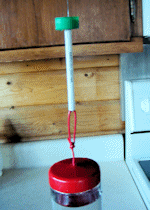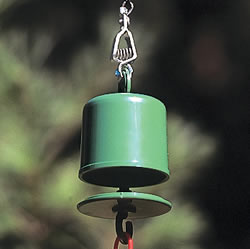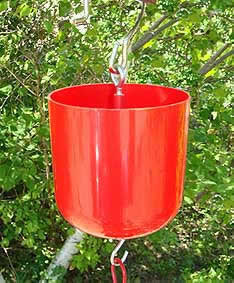Uninvited Guests
Ants
An ant raid on a hummingbird feeder is a big problem. The ants will come in to steal the nectar from the feeder while bringing with them disease and contamination. Ants will also get inside the feeder and start to float in the nectar. And let’s face it, seeing decomposing ant bodies in a feeder is just gross. Hummingbirds find ants annoying and they taste bad. It’s not good to use pesticides near a hummingbird feeder since pesticides are just as bad for hummingbirds as they are for bugs. So what do you do? Here are a few options.
Prevention
First thing to do is to make sure your hummingbird feeder is not leaking. If you live in an area with hot temperatures and have a bottle feeder, the nectar in the bottle can heat up causing the nectar to expand. When this happens, nectar can leak out of the feeder. If you notice this happening, try using a bowl type feeder like any of the HummZinger![]() models. Hanging the feeder with fishing line also works well because ants can have a problem gripping the plastic.
models. Hanging the feeder with fishing line also works well because ants can have a problem gripping the plastic.
Ant Traps
Ant Traps are terrific ways to preventing the ants from invading feeders with minimal maintenance. There is no need to continuously add water like you do with an ant moat. The way they work is that there is a portion of the ant trap that has a sticky substance somewhere between the top of the ant trap and the feeder. Ants don’t want to cross this sticky substance. When getting an ant trap, make sure to get one with a metal hanging device. We had an absolutely wonderful one![]() that had a plastic rod in the center to support the feeder. The rod broke during a small wind event, breaking one of the larger, heavier feeders. We would recommend one that had a stronger supporting rod.
that had a plastic rod in the center to support the feeder. The rod broke during a small wind event, breaking one of the larger, heavier feeders. We would recommend one that had a stronger supporting rod.
Chalk
We have heard of many people who have had great success with using plain white chalk. Use the chalk to mark around the area where the hummingbird feeder is attached for hanging. Ants are not suppose to like crossing over the chalk and will leave the hummingbird feeders alone. Some ants however could care less about chalk and walk right over it. Give it a try. Maybe the ants in your area will be a little pickier.
Fountains
We heard of someone who placed a pole in the center of the fountain pool. She then hung all of her hummingbird feeders off of that pole. The ants where unable to cross the water, the hummingbirds have a nice place to play in the water, and the woman got a wonderful water feature.
Ant Moat
An ant moat is an ant trap that works a little differently. This is a cup filled with water that will prevent the ants from crawling down to a hanging hummingbird feeder. When you fill the cup with water, the ants cannot travel over the water to reach the hummingbird feeder. Ant’s can bypass the ant moat if debris falls into the moat creating a bridge. Some more industrious ants will drown themselves in the moat and eventually fill up the water with ant bodies to create a bridge. If you have an ant moat, it needs to be kept clean, just as you would the hummingbird feeder.
Some feeders will have ant moats built right in such as the feeder such as in the HummZinger![]() feeders.
feeders.
You can also make an ant moat for a hanging hummingbird feeder by following these simple instructions.
 Attach a string to the top of your hummingbird feeder. It is best to use a non-absorbent string like fishing line or wire so there is no issues with a breakdown of material due to wetness.
Attach a string to the top of your hummingbird feeder. It is best to use a non-absorbent string like fishing line or wire so there is no issues with a breakdown of material due to wetness.- String the body of a ball point pen (or large thin bead) on the string.
- Take a cap from a soda bottle or paint can and put a small hole in the center.
- String the cap to rest on top of the ball point pen body.
- Use a hot glue gun or candle wax to seal the hole in the cap to prevent leaking.
- Fill the cap full of water.
- Hang up the feeder. (See image on the right)
That’s it. There are lots of different variations of this. Feel free to send us a picture of your and moat.
Do Not’s
Don’t put any oils, Vicks Vapor Rub, Pam Cooking Spray, Duct Tape, Off, Skin-so-soft, or Vaseline on your hummingbird feeder. These may work slightly. However, hummingbirds have a tendency to fly around frantically and bump into feeders quite often. If there is oily stuff or duct tape on the feeder, it can get into the feathers. The hummingbirds will have a hard time getting it off and it’s not all that good for them. Plus, most of these items will melt in the heat making goo run all over the place. Please don’t use these items.






